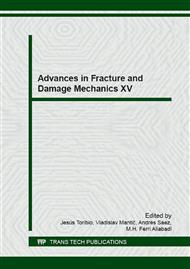p.313
p.317
p.321
p.325
p.329
p.334
p.338
p.342
p.346
Effect of Mean Stress on 2A12-T4 Aluminum Alloy under Tension-Torsion Constant Amplitude Loading
Abstract:
Fatigue tests have been carried out to investigate the effects of mean-stress and phase-difference on the tension-torsion fatigue failure of 2A12-T4 aluminum alloy. The results show that for fully reversed tension-torsion loading, the fatigue life increases with the increase of phase angle, but the fatigue life decreases with the increase of phase angle, when mean-stress exists, both for shear mean-stress and normal mean-stress. Fracture appearance shows that the crack initiation is on the direction of maximum shear stress amplitude plane. Critical plane criteria based on the linear combination of the maximum shear stress amplitude and maximum normal stress are studied and further discussion on the drawbacks of this kind of criteria are performed.
Info:
Periodical:
Pages:
334-337
Citation:
Online since:
September 2016
Authors:
Keywords:
Price:
Сopyright:
© 2016 Trans Tech Publications Ltd. All Rights Reserved
Share:
Citation:


